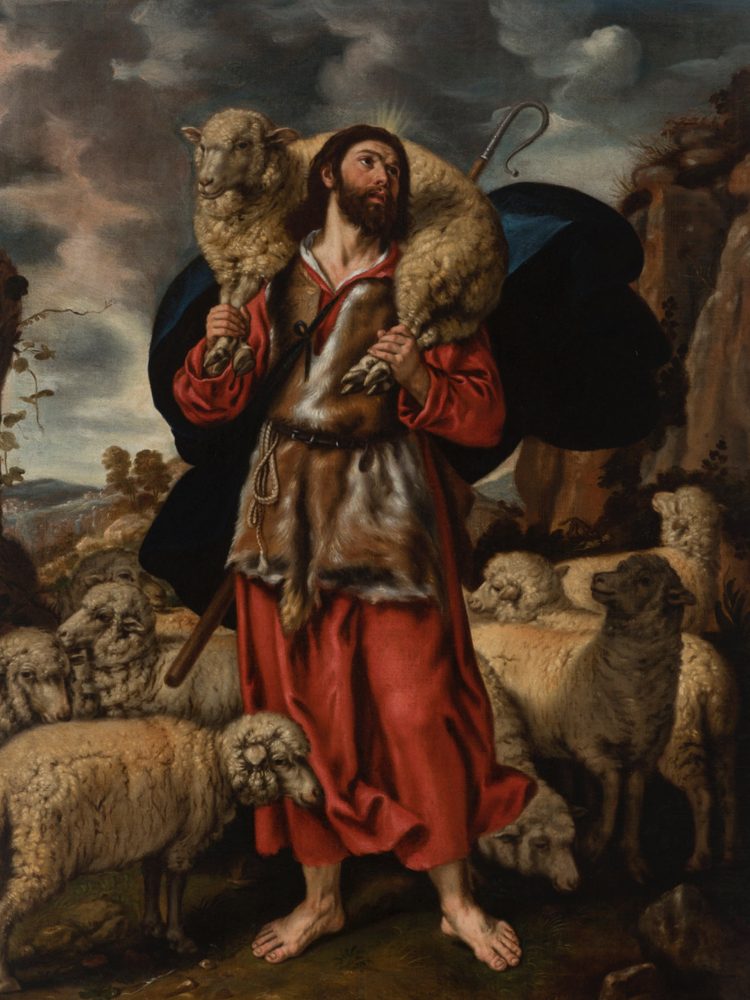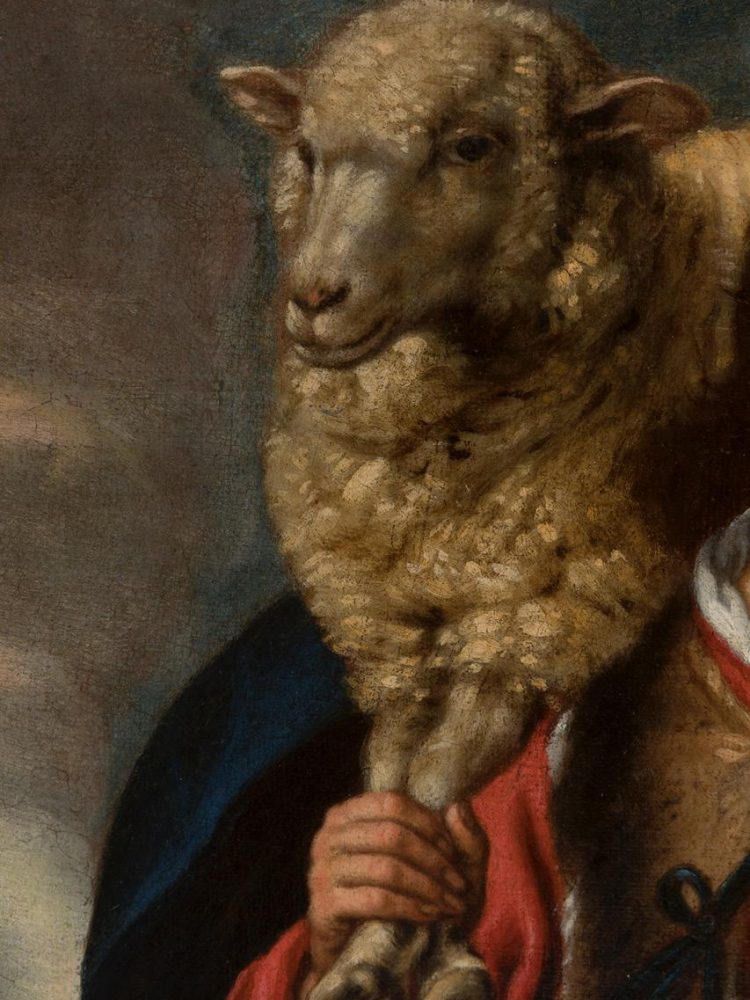The life and work of the painter Cristóbal García Salmerón (Cuenca, 1603 -Madrid, 1673) was largely unknown until recent years due to the lack of studies on this Cuenca-born artist.Nonetheless, he must have been a notable and significant painter for much of the 17th century
given the attention paid to him by authors such as Palomino,1 Ponz2 and Ceán Bermúdez,3 in addition to the more recent texts by Bermejo Díez4 and Angulo Íñiguez and Pérez Sánchez,5 the latter two responsible for the most complete catalogue of the artist’s work at the time of publication.
All these authors repeated the limited data available on the artist, stating that García Salmerón trained as a painter with the Murcian Pedro Orrente and that he was active for much of his career in his career in his native Cuenca and in Madrid. Recent research6, however, has led
to the discovery of numerous documents which allow for detailed information on the artist’s career and oeuvre, to which this Good Shepherd can now be added.
1. Antonio Palomino de Castro y Velasco, El Museo Pictórico y Escala Óptica (Madrid: M. Aguilar Editor, 1947), 942-943.
2. Antonio Ponz, Viage de España en que se da noticia de las cosas más apreciables, y dignas de saberse, que hay en ella.
Tomo III (Madrid: Joachin Ibarra, 1777), 111 y 114.
3. Juan Agustín Ceán Bermúdez, Diccionario de los más ilustres profesores de las Bellas Artes en España.
Tomo I,(Madrid: Real Academia de San Fernando, 1800), 175.
4. Jesús Bermejo Díez, “Un pintor del siglo XVII: Cristóbal García Salmerón. Su obra en Cuenca y en particular larecientemente identificada en
su catedral”, Archivo Español de Arte, Tomo 45, no 177 (1972): 9-22.
5. Diego Angulo Íñiguez y Alfonso Emilio Pérez Sánchez, Historia de la pintura española. Escuela toledana de laprimera mitad del siglo XVII
(Madrid: Instituto Diego Velázquez, 1972), 359-371.
6. Sonia Casal Valencia, Entre el olvido y la historia. Vida y obra del pintor barroco Cristóbal García Salmerón (doctoral thesis, Universidad de
Santiago de Compostela, 2021).
The above-mentioned opinion that García Salmerón trained with Orrente, for example, was based on the idea that either the latter spent time in Cuenca or that García Salmerón was present in Toledo. However, research undertaken on Orrente in recent years has yielded a number of documents which clearly indicate that he was never in either of those cities for the length of time needed to train an apprentice, namely four to five years. This does not mean that García Salmerón’s name should be completely dissociated from that of Orrente, but that rather than an apprenticeship there was an assimilation of his artistic forms, as was also the
case with other painters such as Carducho, Maíno and Tristán (figs. 2, 3 y 4), all of whom undoubtedly influenced García Salmerón’s work. It might thus be closer to reality to consider that he undertook his apprenticeship in Cuenca with one of the dozens of painters active in that city but who are now almost unknown to us due to lack of research on them.

Oil on canvas.
96,5 x 76 cm

Vicente Carducho.
Museo de la Real Academia de Bellas Artes de San Fernando (Madrid).

Juan Bautista Maíno.
Kunstmuseum Basel.

Luis Tristán.
Palacio Real (Madrid).
Whatever the case and despite the fact that there is still no information on the artist’s childhood and youth, by 1624 at the age of twenty-one he is recorded with the status of master painter and as having established his studio in his native city where he remained until 1650 if not later. Notable works from this period include an “Apostles” series of half-length format, now in the Museo Diocesano y Catedralicio, Valladolid, and its incomplete copy in the Museo Nacional del Prado, Madrid, as well as other important canvases such as an Ecce Homo (fig. 6) The repentant Saint Peter (fig. 7) and the Saint John the Baptist Altarpiece (fig. 5), all located in different parts of Cuenca cathedral where the chapterhouse houses another magnificent, full-length Apostolate series by the artist.

Cristóbal García Salmerón.
First third of the 17th Century.
Oil on canvas. Catedral de Cuenca.

Cristóbal García Salmerón. Decade of 1630s.
Oil on canvas. 148 x 118 cm.
Catedral de Cuenca.

Cristóbal García Salmerón.
Oil on canvas. Catedral de Cuenca.
Following that period and at an unknown date García Salmerón moved to Madrid where he spent the last decade of his life, if not longer, dying in late 1673. Surviving works from this period include a Saint Teresa resurrecting her Nephew (private collection) and a Good Shepherd in the Museo Nacional del Prado which reveals notable similarities with the present work (Fig. 1).

7. Juan Agustín Ceán Bermúdez, Diccionario de los más ilustres profesores de las Bellas Artes en España. Vol. I, (Madrid: Real Academia de San Fernando, 1800), p. 93.
With regard to the present work, the size of The Good Shepherd differs from that of most of the artist’s paintings, which are generally well over one meter high. Nonetheless, the composition follows the model of the abovementioned canvas on the same subject in the Museo Nacional del Prado and other anonymous copies of lesser quality, for example the one in the State Hermitage Museum, Saint Petersburg. This suggests that the present version may have been executed at the same period as the example in the Prado, during the final phase of the artist’s career in the 1660s.


The canvas depicts the Good Shepherd located in the centre of the composition, wearing a tunic of a reddish tone with a white shirt under it that is visible at the neck. Over this, an animal skin covers the figure’s torso and is fastened at the waist with a belt. He wears an ample blue cloak and holds a wooden crook with a metal tip of the type used by shepherds to catch their sheep by the legs. The Good Shepherd carries a sheep over his shoulders, holding its front legs with his right hand and its back legs with his left. The animal gazes defiantly at the viewer and there is an evident pentimento around its ears and neck.
The Good Shepherd’s head is slightly turned and raised, revealing small rays of divine light that emanate from it. The figure has abundant chestnutcoloured hair and a beard which frames his face. His gaze and half-open mouth suggest that he is focused on an element outside the pictorial space.
www.magalhaes-santos.com
@magalhaesxsantos

